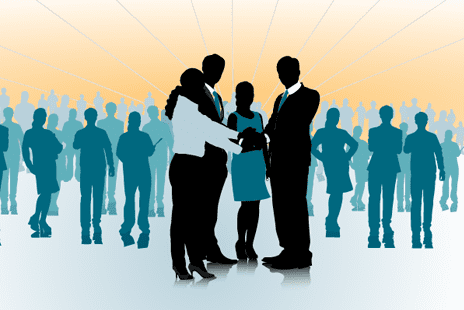Join us as we visit with Vision2Voice’s own Executive Vice President and General Manager, Howard Drazner, as he recaps the last 37 years of biopharma and peer-to-peer medical communications. We discussed how far the healthcare communications industry has come, where it’s going in the future, and whether or not the current pandemic has accelerated that evolution.
You had decades of experience in pharma and healthcare long before you arrived at Vision2Voice. How have you seen medical communications evolve over that time?
Howard: I started my career as a sales rep back in 1983 when there were five thousand sales reps and you could get 15 minutes with a doctor and usually discuss three products, two minor presentations, a major presentation, and maybe even a clincal study. That’s unheard of now. You are lucky if you can get 30 seconds today.

I learned a lot during that period and then had a great opportunity to go to work for a company that specialized in peer-to-peer programs. That’s where I gained an appreciation for the subtleties of peer to peer interaction. When you have clinicians interacting with one another, they like to share their clinical experience. That has been the basis for peer-reviewed journals and transferred to industry executed programs. Clinicians inherently want to know how their peers diagnose and treat patients, which therapies worked well, and which didn’t. What were the side effects experienced along with other treatment-based insights that may help them better their patients. What industry had seen when executing these programs is that prescribing behaviors changed through these peer to peer interactions.
Peer programs started as traditional dinner meetings where a moderator, field representative, and possibly a speaker would go out to dinner with ten or fifteen doctors and have an interactive discussion.
Eventually, regulations came into play, and technology started to evolve, which affected the ways in which programs were delivered, however, what we found is no matter how much shifted, dinner meetings continued to be an important tool for the field sales representatives. However, with the advances in new technology and internet bandwidth, new channels to access HCPs developed. The initial migration was using teleconferences, and that morphed into web-based programs, and now you have virtual environments which can be a potential substitute for a live training event.
Dinner programs have been around for quite some time. Do they still work?
Howard: Initially, we offered many programs with a moderator, representative and participants, but no guest speaker. Then conversationally formatted programs with a speaker became popular which made for a very interesting model because you got a lot of back and forth discussion with the speaker. Say your brand has loyalists and you want them to see the benefits of prescribing more of your product. Getting them to talk about why they prescribe it and what works well really moved the needle for those doctors. Perhaps you also had physicians who weren’t loyal to your brand. So you’d bring in a thought leader or guest speaker to present clinical data and then have open discussion with the participants. Usually the participants were selling themselves or agreeing with the thought leader. Some of the brand people would say, “Well what if somebody doesn’t agree?” “What if they say use the other product?”
I thought those dialogues provided authenticity to the program because you’re never going to have 100 percent of everyone writing for your product. There are going to be people that believe another product is better. Normally what’ll happen in those types of peer programs is a doctor may say, “Hey I’m using product B even though you know you’re talking about product A and here’s why I use product B.”
Then other physicians will say, “I tried it that way, it never really worked for me, but this is what worked for me.” or they would say, “Hey you might not be aware of the following items this product addresses.” The result of the conversational program format is that sometimes you’re able to convert somebody who maybe was a loyalist to another product or was splitting their prescriptions.
What are your thoughts on the power of Peer-to-Peer education and is it still relevant with the technogical changes?

Howard: Peer-to-peer was, still is, and always will be a very important aspect of our industry. The development of technologies made great strides for peer-to-peer compared to back in the day when the internet was in its infancy.
Technology was very challenging back then. We were doing programs that required you to download the presentations to the local computer at the venue, then try to make it work while connecting with limited bandwidth. As we moved to broadcasts from studios or on-site we were driving satellite trucks all around the country and parking them at restaurants. That whole thing evolved to what we’re doing today at Vision2Voice, using OTT (over-the-top) technology.
And if you think about it, coming to Vision2Voice allowed me to get back to and utilize all of the skills and lessons learned from all those various jobs and projects I’ve worked on as a provider of peer interactive medical communication programs. It’s amazing how thirty-seven years can go by so fast.
Peer-to-peer programming allows clinicians to share their own personal clinical experience with a particular product. If you think about it, products go through all of the FDA testing and then they’re approved but you really don’t know how the product is going to work until it’s out in the public domain being taken by patients with a wide variety of comorbid conditions.
With peer-to-peer communications, you hear firsthand how a product works. Some work really well and some don’t. The clinicians who are treating patients are on the front lines saying, “Hey I know this dosage works really well, but if I’m using it with this other product it creates issues. Have you encountered this?.” Sharing those experiences with other clinicians has a tremendous impact on how they learn and how they make decisions to use a given product for a given disease state and in turn, how they treat the patient.
Think about it, you want your physician to be knowledgeable, well informed, and spending time talking with other doctors. When you have an issue, you want to make sure you’re given the right product that will get you on the mend or take care of your situation in a quick and safe manner.
Peer dialogue helps to confirm real scenarios and can affirm what others on the frontlines are seeing and if it’s consistent.
It’s that exchange of communication between experts and HCPs that gives prescribers so much more additional and real information to use when making their own decisions.
Is Medical Communications growing in importance? How do you see it changing in the future?
Howard: Medical communications has been and will always be here in some form. Back in the day you had advertising and medical communications merged into one agency, so they were doing a lot of the mainstream advertising content development combined with the actual tactical components of medical education. That seems to have changed over the years where you have companies like Vision2Voice that are primarily medical communications agencies specializing and doing the work with speakers, working with key opinion leaders, working with brand teams to help drive the right strategies that ensure physicians are getting important information about a particular brand to make educated decisions and improve patient care.
In my estimation, HCP education will always continue because there’s perpetually that need to explain, understand, provide, and communicate; whether it be from a sales rep, in an association meeting or a virtual program. I think technology will drive some of the delivery aspects but the true method of communicating medical messaging will always be there.
What key advice would you give for a successful peer-to-peer program?
Howard: What makes for a really effective program is when you have a first-class product that no one has a lot of experience with and everyone’s really curious about seeing how it’s going to work. That is clearly a dream product but when you think about it, content must be well-written. It should be put forth in a method that can be communicated effectively.
You must have a good speaker that can communicate well, not just be didactic, but truly interactive. You need platforms or programs that will reach your entire audience because there are doctors that like to go live and there are doctors that like virtual. Some don’t see representatives and just read journals. There is a whole mix. I look at it like it is a campaign; you have to manage it with some type of virtual platform. You should be reaching people frequently with a good compelling message; one that is not the same thing over and over and over again. When I was out in the field, I always had a fallback presentation. I would go and see a physician every four weeks. After the fourth time going through, you need to either have a good discussion about some issue or something pertinent to share with them because they’re going to say, “Wait, you’ve already told me this four times. What else do you have in your bag?”
What insights can you share about effective HCP marketing in the current environment?
Howard: The marketing mix is very important. Over the years I’ve been very fortunate to be involved in some of the biggest launches around. From direct marketing to peer-to-peer campaigns, I saw firsthand how different tactics help drive change in behavior. Utilizing different channels to communicate was interesting and has evolved to identifying the right mix of traditional marketing and technology to maximize reach.
Now our programs often cross over. We’re doing face-to-face and virtual live in the same event which means more people are apt to come, better our database penetration, and provide consistent messaging across the program which is important to ensure that what’s being said in one part of the country is being repeated in the other.
Going back as far as I go, there were certainly some very interesting programs that I didn’t often favor. I mean there were programs called dine and dash, there were companies giving away VCRs, they were giving away trips, all just to get people to show up. Over time, regulations came and put an end to those practices, but doctors still go to programs. Why? HCPs go to a program because they want to interface with their peers. They want to understand and learn because there’s only so much you can get by reading a journal. Physicians get a lot out of them, but the programs have to be more innovative. You can’t just have a didactic lecture today. That’s one of the things that we try to do when we develop programs for our customers; how do you leverage the clinical expertise and the presentation component with the right technology to make it an interesting discussion?
What do you see coming in the future for Healthcare Communications overall?
Howard: I think it’ll be interesting to see the type of innovation coming. The science is going to drive innovation, which is going to drive new products coming out and how they’re delivered.
I believe you’ll always have face-to-face. You’ll have people interfacing with one another. COVID-19 forced the industry to make some interesting changes. We were on the forefront of this shift at Vision2Voice, with our virtual program offerings.
Prior to the pandemic, there were some companies that were really interested in the tech, sticking their toe in the water, but now they have no choice. If you want to communicate but you can’t meet in person, then you’ve got to figure out another way to communicate. How do you train your speakers? They still need to be certified. You’ll always have innovation with technology which will eventually drive change in the way messaging is delivered, but I think the current environment has accelerated the adoption of technology quite a bit.
I think representatives will continue to call on clinicians. Representatives may utilize technology differently because they were forced into it. We literally have converted live dinner meetings into virtual live programs within a couple of weeks for some of our customers.
We’re getting in many instances up to 20 people to a program. They’re engaged. There is tremendous value in that. I think the pendulum will shift. Things do ebb and flow and I think it will normalize but the appetite for pharmaceutical companies and for HCPs to interact virtually will only increase.
Many of them are finding it is not that big black hole they thought it was. It’s actually user friendly and you don’t have to get on a plane, fly somewhere, spend an extra day traveling back and forth when you can achieve the same thing virtually. We are certainly going in that direction, but I’m an old school salesperson. I still think there’s nothing better than getting in front of somebody you know and seeing them face-to-face. Finding the perfect combination of virtual and in-person interactions is going to be an important aspect of the marketplace going forward.




